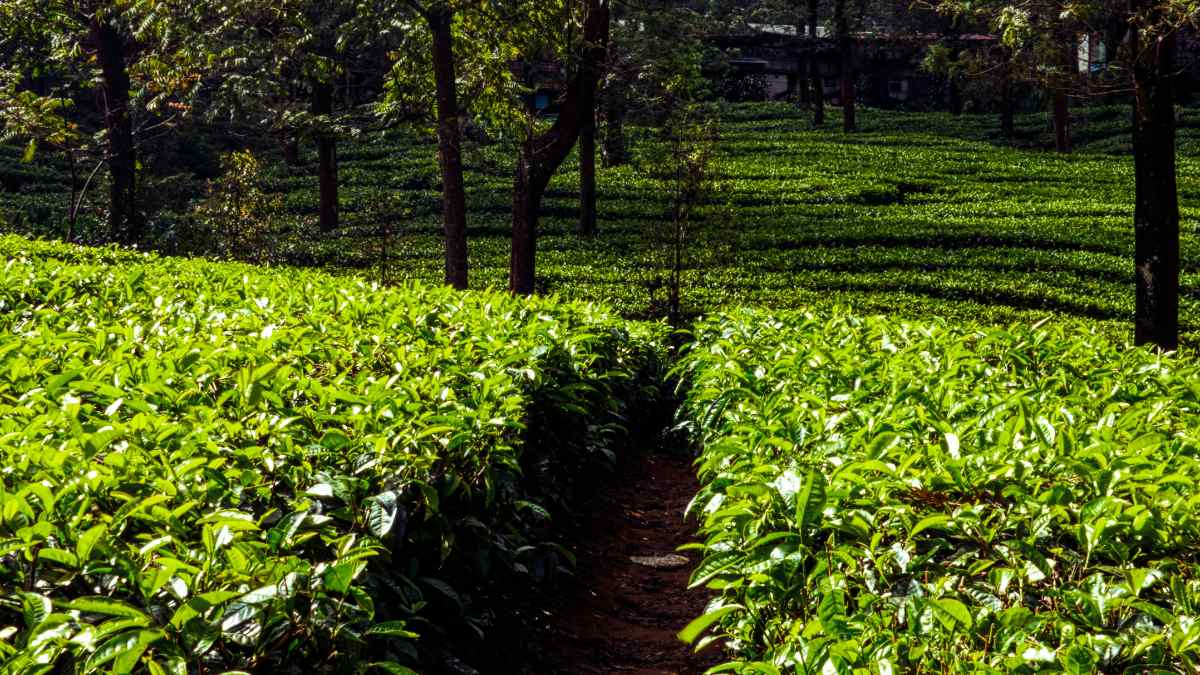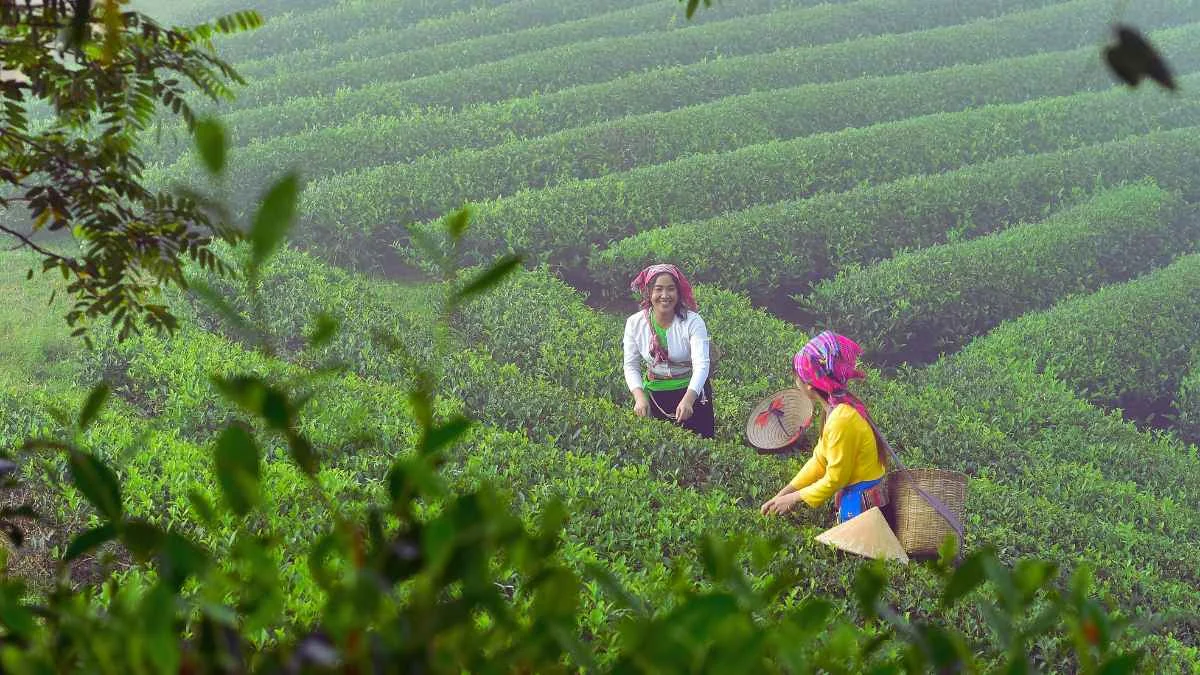Have you ever wondered where your cup of tea comes from? We all know it’s delicious and comforting, but what about the process behind it?
Tea doesn’t just appear in a bag or tin—it’s the result of hard work, careful farming, and special plants grown in faraway places called tea plantations.
These plantations are where tea is grown, picked, and processed before it makes its way to our cups.
In this blog post, we’ll explore the fascinating world of tea plantations. We’ll learn how tea is grown, where it comes from, the different types of tea, and even the health benefits of drinking tea.
Along the way, we’ll also touch on how tea plantations impact the environment and local communities. So, grab a cup of tea, and let’s dive into the world of tea plantations!

What Is a Tea Plantation?
A tea plantation is a large farm where tea plants are grown. The scientific name of the tea plant is Camellia sinensis. These plants are grown in many different parts of the world, but they all need a special climate to thrive.
Tea plants grow best in warm, humid weather and in areas with lots of rainfall. That’s why you’ll often find tea plantations in tropical and subtropical regions.
Some of the most famous countries for tea plantations are China, India, Sri Lanka, and Kenya. In fact, these countries have been growing tea for hundreds of years, and they are home to some of the best tea farms in the world.
How Does Tea Grow?
Growing tea isn’t as simple as planting seeds and waiting for them to grow. Tea plants need a lot of care, and the process takes years to get right. Here’s how tea is grown:
-
Planting the Tea: It all starts with planting the tea seeds or young plants in the soil. These plants are often kept in special nurseries until they grow strong enough to be moved to the plantation fields. The soil needs to be rich and well-drained for the plants to grow well.
-
Growing the Tea Plants: Tea plants take about three to five years to fully mature. The plants grow in neat rows, and their leaves are picked carefully. The best tea leaves come from the top of the plant, which are the freshest and most tender.
-
Picking the Leaves: Picking tea leaves is a delicate job. Workers, often known as “tea pluckers,” carefully pick the young leaves by hand. The leaves are usually picked in the early morning, when the tea plants are fresh and dewy.
-
Processing the Leaves: Once the leaves are picked, they need to be processed to make different types of tea. The leaves can be turned into green tea, black tea, oolong tea, or white tea, depending on how they are prepared.
-
Green Tea: The leaves are quickly dried or steamed to keep them from turning brown.
-
Black Tea: The leaves are allowed to oxidize (turn brown), which makes the tea stronger in flavor.
-
Oolong Tea: This tea is somewhere in between black and green tea, as it is only partially oxidized.
-
White Tea: This is the least processed tea. The leaves are simply dried in the sun.
-
Drying and Sorting: After processing, the leaves are dried to lock in their flavor. They are then sorted by size and quality before being packaged for sale.
Read Next: Afternoon Tea | How to Sip, Snack, and Socialize in Style
Where Are the Best Tea Plantations?
Tea grows best in countries with the right combination of climate, soil, and altitude. Some of the most famous tea-producing regions in the world include:
-
India: India is home to some of the most famous tea plantations, like Assam and Darjeeling. Assam tea is known for its bold, malty flavor, while Darjeeling tea is often called the “champagne of teas” because of its light, floral taste.
-
China: China is the largest producer of tea in the world. It’s also home to many different varieties of tea, such as green tea (like the famous Longjing tea) and white tea.
-
Sri Lanka: Sri Lanka, known as Ceylon in the past, produces some of the best black tea in the world. Ceylon tea is bright, lively, and has a strong flavor.
-
Kenya: Kenya is one of the largest producers of tea in Africa. The country is known for its strong, flavorful black teas, which are often used in tea blends.
Different Types of Tea:
There are many different types of tea, and each one has a unique flavor. Here are the main types of tea that come from tea plantations:
-
Black Tea: This is the most popular type of tea around the world. Black tea is fully oxidized, which gives it a rich, strong flavor. It is the kind of tea most people drink with milk or sugar.
-
Green Tea: Green tea is less processed than black tea. The leaves are steamed or dried quickly to prevent oxidation, which keeps them green. Green tea has a lighter, fresher taste.
-
Oolong Tea: Oolong tea is a partially oxidized tea, meaning it falls somewhere between green and black tea in terms of flavor and color. It can range from light and floral to thick and full-bodied.
-
White Tea: White tea is made from the youngest leaves of the tea plant. It is very delicate and has a light, sweet flavor. It is often the least processed of all tea types.
-
Herbal Tea: While not technically made from the Camellia sinensis plant, herbal teas are also very popular. These teas are made from flowers, fruits, herbs, and spices, such as chamomile and peppermint.
Health Benefits of Tea:
Drinking tea isn’t just enjoyable—it also comes with some great health benefits! Tea contains antioxidants, which are compounds that help protect your body from harmful substances. Drinking tea regularly can help improve your health in many ways:
-
Boosts Immunity: Tea contains compounds that can help your body fight off infections. For example, green tea is packed with antioxidants called catechins, which are known to boost your immune system.
-
Improves Heart Health: Studies have shown that drinking tea regularly can help reduce the risk of heart disease by lowering cholesterol levels and improving blood flow.
-
Helps with Digestion: Peppermint tea and ginger tea can help soothe your stomach and improve digestion.
-
Promotes Relaxation: Certain teas, like chamomile and lavender tea, have calming properties that can help reduce stress and promote better sleep.
Impact of Tea Plantations on the Environment and Workers:
While tea plantations provide jobs and support local economies, they can also have a negative impact on the environment.
Large tea farms can contribute to deforestation, soil erosion, and water pollution. This is because the land needs to be cleared for planting, and chemicals like pesticides and fertilizers are often used.
In addition, workers on tea plantations sometimes face difficult working conditions, including low wages and long hours. Many tea plantation workers live in poverty, and there have been concerns about the treatment of workers, especially women and children.
To address these issues, many tea plantations are adopting sustainable farming practices. This means using eco-friendly farming methods, reducing pesticide use, and planting trees to help protect the environment.
Some tea companies are also supporting fair wages and better working conditions for plantation workers through programs like Fair Trade and Rainforest Alliance certification.
Final Words:
Tea plantations are more than just farms—they are where the magic of tea begins. From the careful planting of the tea seeds to the handpicking of the leaves, there’s a lot of work that goes into every cup of tea we enjoy. Whether it’s a strong black tea, a delicate green tea, or a soothing herbal tea, each type of tea offers a unique flavor and health benefits.
As we sip our tea, it’s important to remember the hard work that goes into making it and the impact tea farming has on the environment and the people who grow it.
By supporting ethical and sustainable tea practices, we can help ensure that tea continues to be a beloved beverage for generations to come.
References:
-
Dr. Michael Mosley, “The Health Benefits of Tea,” BBC Health, 2023.
-
Dr. John Weisburger, “Tea and Antioxidants,” American Cancer Society, 2023.
-
Dr. Christopher Ochner, “The Role of Green Tea in Weight Management,” American Journal of Clinical Nutrition, 2023.

